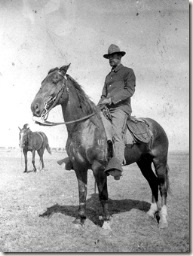Horse Crazy: Equine insanity tends to hit around the Stampede
By Peggy A. Ford
Originally published in the Weld County Times, June 19, 1999
This time of year I always think of horses. I grew up in Monte Vista in Colorado’s San Luis Valley, and summer meant riding horses and attending the rodeo. A mile from our home stood the fairgrounds and the Ski-Hi Stampede grandstands and arena. I often meandered over to watch the cowboys and cowgirls practice roping, riding and barrel racing.
 Based on an essay I wrote in the third grade, my life’s ambition was to have my own horse and be a champion barrel racer. I loved that writing assignment, because heaven in my eyes was only as high as the back of a horse! In the absence of a horse, my blue American Flyer bicycle doubled as a surrogate steed as I raced at breakneck speed down graveled roads and did tight maneuvers around the garbage cans and boxes I set up “rodeo style” in a vacant lot to practice “barrel racing.”
Based on an essay I wrote in the third grade, my life’s ambition was to have my own horse and be a champion barrel racer. I loved that writing assignment, because heaven in my eyes was only as high as the back of a horse! In the absence of a horse, my blue American Flyer bicycle doubled as a surrogate steed as I raced at breakneck speed down graveled roads and did tight maneuvers around the garbage cans and boxes I set up “rodeo style” in a vacant lot to practice “barrel racing.”
When the Greeley Independence Stampede’s advertising and excitement hit the city toward the end of May, I get nostalgic about horses, and think of the colorful local characters who were also “horse crazy.” These included Lord Ogilvy who loved fast horses and horse play. Fond of his horse, Trooper, Ogilvy once tried (reputedly) to “house break” the critter by leading him upstairs to tuck him into bed! I always wondered if this was a “stable” thing for Ogilvy to do!
Dode Wykert of Severance participated in the Denver Post’s Endurance Race of cow ponies from Evanston, Wyo. to Denver on May 30, 1908. Wykert and his horse, Sam, completed the challenge in 152 hours and 18 minutes. Locally, Wykert was regarded as “Colorado’s Greatest Horseman.”
Greeley’s Minnie Pinneo Arthur achieved fame on the equestrienne jockey relay race circuit from 1880 -1883. And the two Elliott brothers – Verne and Ivan Jack from Platteville – became prominent rodeo producers. Verne owned two of the greatest bucking horses in rodeo history, Midnight and Five Minutes to Midnight.
Verne was born on the family ranch west of Platteville on July 1, 1890, and competed in rodeos during his youth. During a 1917 Cheyenne Frontier Days event, he was hurled off a bronc with such force that he wisely opted for a career change. Instead of rodeo riding, he got into the business of providing first class rodeo stock for venues around the country, and was known as the “Dean of Rodeo Producers.” Both Verne and Ivan Jack rode in Buffalo Bill’s Wild West Show and in 1922, Verne was instrumental in promoting the first rodeo held in Madison Square Garden.
He produced scores of other rodeos including the old Greeley Spud Rodeo, the Calgary Stampede, Brussels World Fair rodeo and venues at Fort Worth and Soldier’s Field in Chicago. Verne and his partner, Ed McCarty, introduced the riveting Brahma bull riding event at the Fort Worth rodeo in the 1920s, along with a grand entry entourage of mounted rodeo contestants carrying flags and banners.
As his reputation grew, Elliott eventually accumulated 500 horses and cattle valued at more than $200,000 including Midnight, Five Minutes to Midnight and Black Powder. Midnight was foaled on a ranch near McCloud, Alberta, Canada in 1910, and by age 9 had foiled every cowboy on the Canadian circuit who tried to ride him. In 1928, Verne Elliott purchased the 18-year-old horse for $250. Verne hit “pay dirt” with Midnight that same year when he bucked off every cowboy at the Fort Worth rodeo. Verne promoted Midnight as “the greatest bucking horse that ever lived.” Midnight’s career under Elliot’s ownership was relatively short-lived.
“Official” retirement came for Midnight following the 1933 Cheyenne Frontier Days Rodeo. However, Midnight performed in four exhibition rides in 1934, in London. Two years later on November 5, 1936, Midnight died of old age and was buried on the Elliott ranch. His grave was located a mile north and 3.5 miles west of Platteville near the St. Vrain River. A marker with the following inscription was placed on his grave:
“Under this sod lies a great bucking hoss
There never lived a cowboy he couldn’t toss
His name was Midnight, his coat black as coal
If there is a hoss heaven, please God rest his soul.
…By a cowboy… Gene Lindberg.”
In 1966, Midnight’s remains were disinterred and moved to the National Cowboy Hall of Fame in Oklahoma City, where he, and Five Minutes to Midnight are buried on “The Trail of Great Bucking Horses” near the museum.
Verne once described Midnight as a killer horse that nobody could love, let alone ride. Five Minutes to Midnight was a smaller horse who bucked because he liked to “show off” for an appreciative audience. Verne died on June 22, 1962, and is buried in Platteville’s Mizpah Cemetery. In 1972, he was inducted into the Cowboy Hall of Fame, a Weld County resident recognized for his contributions to the sport of rodeo.